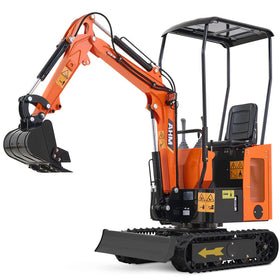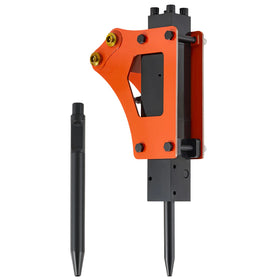A quick hitch simplifies the process of manually swapping attachments on your mini excavator, making your workday smoother and more productive. In this guide, we'll break down everything you need to know about quick hitches - how they work, why they're worth it, and how to use them safely on your mini excavator.
(Reading time 4 ~ 5 minutes)
1. What is a Quick Hitch and Why It’s Essential for Mini Excavator
A quick hitch is a connector system that attaches to your mini excavator's arm, designed to make switching between buckets, augers, and other attachments faster and more straightforward. Instead of wrestling with multiple pins and potential alignment issues, a quick hitch gives you a more streamlined process.
The benefits are pretty straightforward:
- Faster Changes: While you'll still need to leave the cab, you're looking at a much quicker process than traditional pin-and-clip attachment methods
- Better Safety: Less time spent manually handling heavy attachments means lower risk of injuries
- More Efficiency: When switching attachments is easier, you're more likely to use the right tool for each specific task
A quick hitch saves you time and hassle on attachment changes, making your mini excavator more versatile. But to get these benefits, you need to understand how these systems actually work - let's dive into that next.

2. How Does a Quick Hitch Work?
As we’ve seen, a quick hitch can make a real difference in your mini excavator operations by simplifying attachment changes. But how does it actually work, and what makes it effective?
A quick hitch, like the AHM quick hitch, operates by securely latching attachments to the mini excavator’s dipper arm, allowing you to swiftly connect and disconnect tools without extra hassle. It's basically a connecting piece that mounts to your excavator's dipper arm, with a locking mechanism that grabs and secures your attachments. The system is pretty straightforward: you've got mounting points that align with your attachment's pins, and a locking system that keeps everything secure once you're connected.
Key parts you need to know:
- Mounting Frame: The main body that connects to your excavator's arm
- Locking Mechanism: Usually mechanical or hydraulic, this is what actually grabs and holds your attachments
- Safety Catches: Backup systems that prevent accidental release
This practical, durable design helps ensure that your mini excavator stays versatile and ready for any job. In the next section, we’ll look at choosing the right type of quick hitch for your mini excavator, covering essential factors to consider for compatibility, durability, and ease of use.

3. Choosing the Right Quick Hitch for Your Mini Excavator
The market's full of options, but getting the right quick hitch comes down to three main things:
Here are key factors to consider when choosing a quick hitch:
3.1 Compatibility with Your Mini Excavator:
Not all quick hitches are designed to fit every mini excavator model. For instance, the AHM quick hitch is built to be compatible with mini excavators up to 2 tons, with precise dimensions like a 3.62-inch span and a 0.98-inch pin diameter that ensure secure attachment. Verify the hitch’s dimensions and specifications against your excavator’s arm and attachment points to ensure a snug fit.
3.2 Attachment Versatility:
A well-designed quick hitch is versatile enough to handle a variety of mini excavator attachments. If you’re frequently switching between buckets, augers, rakes, and other tools, choose a quick hitch that can accommodate different attachments easily. This versatility boosts productivity by enabling seamless transitions from one task to another without changing the hitch itself.
3.3 Durability and Material Quality:
Quick hitches endure significant strain and exposure, so material quality is crucial. The AHM quick hitch, made from high-hardness manganese steel, offers resistance to wear and rust, making it a reliable choice for demanding tasks in construction, landscaping, and demolition. Durable materials not only extend the hitch’s lifespan but also reduce maintenance needs, helping operators avoid interruptions on-site.
3.4 Ease of Installation and Use:
Look for a quick hitch that comes with clear instructions and essential parts for installation, like hinge pins and nuts, which simplify setup. The AHM quick hitch, for example, includes all necessary components, allowing for a straightforward installation that minimizes downtime. A user-friendly design means faster setup and attachment swaps, which directly translates into improved productivity.
When selecting a quick hitch, consider proven options like the AHM quick hitch, which is specifically designed for mini excavators up to 2 tons. Its high-hardness manganese steel construction offers excellent durability for daily use, while the 3.62-inch span and 0.98-inch pin diameter provide reliable compatibility with common attachments. This kind of precise engineering in a quick hitch means you won't waste time dealing with fit issues or premature wear.
By focusing on these features—compatibility, versatility, durability, and ease of use—you can choose a quick hitch that meets the specific needs of your mini excavator and job requirements. In the next section, we’ll cover practical steps on how to safely and efficiently use a quick hitch, ensuring you get the most out of this essential tool.
4. How to Safely and Efficiently Use a Quick Hitch
Once you’ve chosen the right quick hitch, knowing how to use it correctly is essential for safety and efficiency on the job. Improper use can lead to attachment failures, downtime, or even safety hazards, so it’s worth reviewing key steps and best practices for safe operation.
4.1 Inspect the Quick Hitch Before Use:
Before starting any attachment change, inspect your quick hitch, especially the hinge pins, locking mechanisms, and attachment points. Check for signs of wear or damage, such as rust or loose components, as these can affect performance.
4.2 Securely Lock Attachments:
After connecting an attachment, make sure the hitch’s locking mechanism fully engages to prevent any risk of detachment during operation. If you’re using a hydraulic quick hitch, engage the hydraulic system to confirm a firm lock without leaving the cab. For manual models, double-check that the pins are fully seated and locked.
4.3 Stay Aware of Load Limits:
Mini excavator attachments that are too heavy for the hitch can strain both the hitch and the mini excavator, leading to equipment damage. Refer to the specifications for your specific model, like the AHM quick hitch’s suitability for mini excavators up to 2 tons, to avoid overload issues.
4.4 Engage in Controlled Movements:
Once an attachment is secured, use controlled, steady movements while operating the mini excavator. Avoid sudden jerks or rapid changes in direction, as these can place extra stress on the hitch and increase wear on the locking mechanism. Smooth, deliberate actions will help maintain stability and prolong the lifespan of both your hitch and attachments.
4.5 Regular Maintenance:
Keep the locking mechanism and pins clean and free from debris, lubricate moving parts periodically, and replace worn parts as needed. Routine maintenance helps ensure that your quick hitch, such as the AHM model, continues to operate safely and reliably over time.
By following these safety and efficiency tips, you can make the most of your quick hitch and enhance your mini excavator’s productivity on the job. In the final section, we’ll wrap up with some insights on maximizing versatility and productivity with the right quick hitch setup.

5. Getting the Most Out of Your Quick Hitch
Experienced operators know that maximizing the value of a quick hitch goes beyond just making faster attachment changes. Here's how you can make your quick hitch work harder for your mini excavator operations:
5.1 Smart Job Planning for Fewer Swaps
Planning your attachment sequence can significantly reduce downtime. Before starting complex jobs, map out your tasks in order of efficiency rather than convenience. For instance, when your project involves both trenching and grading, complete all trenching work first before switching to your grading bucket. This strategic approach minimizes the number of attachment changes needed throughout your workday.
5.2 What Should You Check During Daily Inspections?
A thorough inspection routine is crucial for safe operation. Start each day by checking your quick hitch's lock indicator position - it should be clearly visible and properly aligned. Examine pin wear patterns, as uneven wear often signals alignment issues that need attention. For hydraulic quick couplers, inspect the lines for any signs of wear or potential leaks. Keep attachment mounting points clean and well-lubricated to prevent excessive wear.
5.3 How Often Should You Maintain Your Quick Hitch?
Follow this comprehensive maintenance schedule to extend your quick hitch's lifespan:
- Daily maintenance involves removing packed dirt and debris that could affect proper locking.
- Weekly maintenance should include thorough greasing of all points, particularly the locking mechanism.
- Monthly checks need to cover all wear points and safety features in detail.
- Seasonal maintenance requires a complete system inspection, including checking hydraulic pressure for quick couplers.
5.4 Why Does Proper Maintenance Matter?
A well-maintained quick hitch not only works more efficiently but also provides better safety and reliability. Regular maintenance prevents unexpected downtime and extends the life of both your quick hitch and mini excavator attachments. When operators take care of their quick hitch system, they're protecting their investment and ensuring smooth operation across various job site conditions.
Your quick hitch is an essential tool that bridges your mini excavator and its attachments. By following these maintenance practices and operating guidelines, you'll get the most value out of your investment while keeping your work efficient and safe.
6. Conclusion
Is a quick hitch worth the investment for your mini excavator? If you're regularly switching between tasks or working with multiple attachments, the answer is clear. A quality quick hitch, properly chosen and maintained, pays for itself in saved time and reduced physical strain.
Every minute saved on attachment changes is a minute you can spend actually getting work done. Whether you're tackling demolition, landscaping, or construction projects, the right quick hitch keeps your mini excavator working efficiently and helps you stay competitive on the job.







